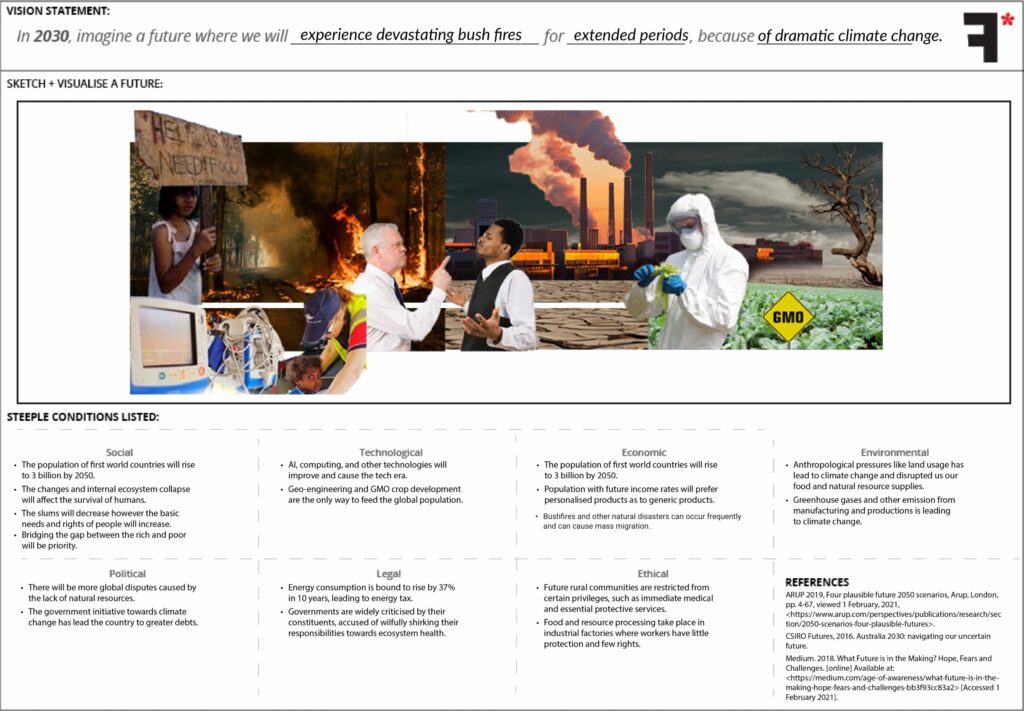Research into the Problem Space
The ARUP scenario “Extinction express” describes a future where population growth, climate change and natural disasters are going to cause a troubled survival rate for all nations. Annual reports from CFA raises concerns about funding issues towards bushfire management. Though bushfires have been common natural disaster in Australia, bushfires occurrence and the intensity have tripled over the last 30 years. In order manage this disaster, efforts are required at multiple levels to secure safe future. This includes clearing dead vegetation without affecting the wildlife habitats, controlled burning and strategic safety measures for nearby communities like bunkers.
“More than 80 per cent of Victoria’s fires are contained as small fires of less than five hectares. The remaining 20 per cent of fires account for 90 per cent of the total area burnt each year.”
Need finding
We had an opportunity to gather insights from an interview of a resident living near bushfire prone area. We discovered issues with evacuation and staying indoors. There is conflict on how people at the community think, as some wish to leave the area during a fire and other prefer staying indoors and need a bunker. Other issues within the community includes communication and information available regarding bushfires, as the data shared with them is fragmented and not clear enough. The residents near the bushfire prone areas are readily packed to leave their house especially during extreme summers, high windy days.
We discovered that the funding and grants from the government is only distributed for recovery, as when they can use it for building defense mechanism for a safe community. This gave us more idea around civilian challenges and perspective to device a concept around their needs.
Futures Canvas and Scenario for 2030
Climate change is going to get worse and trigger many more challenges for our survival in the future. Victoria will suffer tripled the disasters, including bushfire every year costing us essential resources. The population will double, causing an urban sprawl where people will be forced to live in peri-urban areas which are prone to bushfires. Government will have global disputes over resources and living of GMO (Genetically Modified Organisms) crop development. The gap between the poor and rich may grow bigger and leading scenarios where rural communities are restricted from certain privileges. The future we speculate provides insights various issue and population growth contributing more towards climate change is going be the cause for more bushfires. Hence, our problem space is going to grow worse in the future and needs suitable solutions.
A speculative future of 2030

Classification of fires and firefighting solutions
There is various fire classification that is used to decide, which methods must be used to extinguish the blaze. These classification help fire brigade officials to estimate the time it takes to extinguish the fire and plan emergency evacuation procedures. Bushfires has not been classified within any of these categories as evacuation and extinguishing the fire is mandatory. As part of benchmarking, we discovered various product and tools that exist to aid with firefighting, but very few of these solutions are designed for putting out bushfires.
Some of these products are still at test, while some are used globally. Products like the “Gel spray” developed by experts at Stanford university, USA is still at test and was originally designed to be a small-scale fire retardant, to reduce grass land fires. Fire resistant Insulation like “Aerogel” is currently used, layered between materials for fireproof surfaces and is used in firefighting uniforms. The Bushfire Research Centre in Australia developed the “mist bomb” that is filled with water, to be dropped from an aerial vehicle on the bushfire affected areas but has not been proven a success. Research is still being conducted on all the above products whether they can be used in case of large and destructive bushfires.
Fire extinguishers are used to extinguish and contain small fires and is not useful for bushfires, while fire retardants a chemical composition has proven to prevent spread of bushfires. However, using these retardants can pollute water, soil and wildlife habitats and takes a long raining period to washout. Our aim is to provide a safer and successful solution that is planet centered, and sustainable to be used in the “Helios” system for 2030.
Regular Team Snapshots

Highlight of the week was kicking off the Design development and exploration festival. Collaboration with other teams and other activities such as scavenger hunt fuels our productivity and creativity.
Meetings like these

“Coincidentally we discovered working continuously over a virtual meeting
reduces productivity and induces deep sleep.”
Quote by the Earthlings
Next Steps
As we dive into the Phase 2 (Research and development phase) of our DFM Global program, our next steps include more need finding, contacting various stakeholders,developing and prototyping various design concepts.

Recent Comments